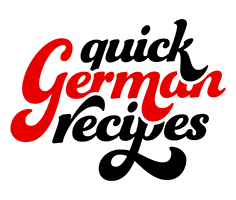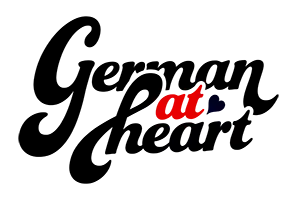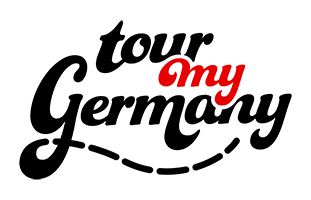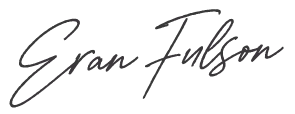Save up to 50% on all digital items with our Last Minute Christmas Sale on now!
- Home
- Castles in Germany
- Cochem Castle
Reichsburg Cochem Castle in Germany : A Mosel River Landmark Near Frankfurt
By: Lydia Fulson / Writer, Pyrography Artist, Thrill Seeker, and Traveler
Behold: Reichsburg Cochem Castle in Germany—otherwise known as the Imperial Castle Cochem. This eye-catching acropolis stands on a hill over 300 feet above the serene Mosel River, which runs through the small city of Cochem.
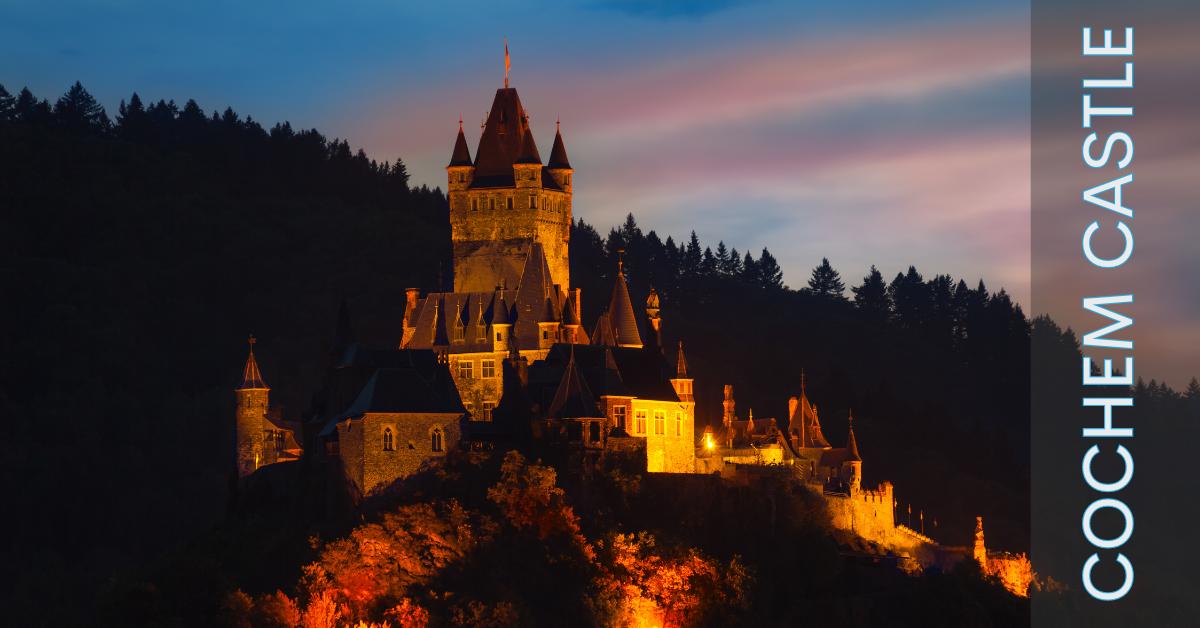 Yikes, I wonder what that electricity bill is like
Yikes, I wonder what that electricity bill is likeThe name of this castle, or should I say, names, often confuse travelers. Why on earth does it go by so many names? It's a mystery that adds to its allure. Even as I was learning about it, I was a little intrigued...
A castle of many names and personalities, it certainly is.
- Reichsburg Castle
- Cochem Castle
- Cochem Imperial Castle
- Cochem Reichsburg Castle
- Cochem/Moselle
- Reichsburg Cochem
- Imperial Cochem Castle
On this page:
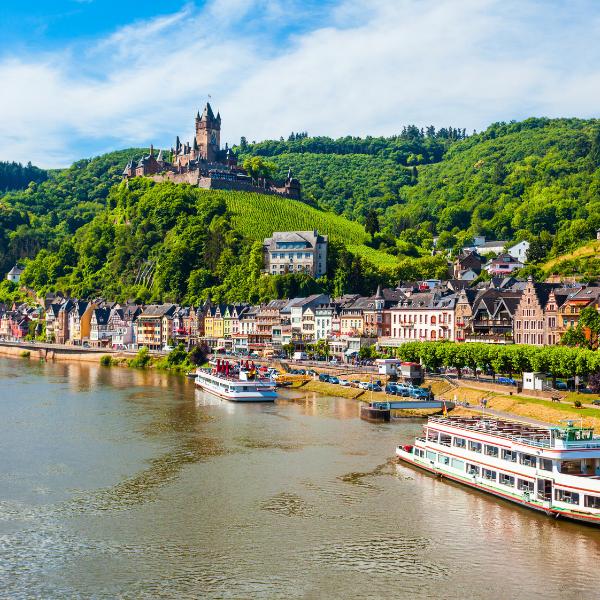 Do you dream of being on one of these boats? Keep reading to find a great panoramic boat ride where you'll see views like this!
Do you dream of being on one of these boats? Keep reading to find a great panoramic boat ride where you'll see views like this!That's My Name, Don't Wear it Out!
WHY so many names? To many foreigners, it's more commonly known as Reichsburg Castle, with Reichsburg translating to "Imperial Castle"—hence my calling it the Imperial Castle Cochem up top.
Keep reading to learn the other ways the imperial name came to be.
Cochem appears in the name due to the location of this great fort along the Mosel River in the old-style town of Cochem, Rhineland-Palatinate.
From all of these, a lot of different names emerged. But when visiting Cochem, don't be shocked if the locals call it by a completely different name than the one you've been calling it. There are just so many nicknames for this towering beauty! :)
Moselle or Mosel?
This relaxing river starts in the Vosges mountains, runs around and about north-eastern France and Luxembourg, and runs to western Germany.
Moselle is the French name, meaning "Little Meuse," and Mosel is the German name.
Where To Find Me
Distance from Frankfurt: 105 miles (170 kilometers)
Cochem Castle isn't located in Frankfurt, but it makes for a great day trip!
If you're starting your day off in Frankfurt, take the train for an easy trip rather than the whole rent-a-car process (which can add up in price really quickly depending on the length of your stay).
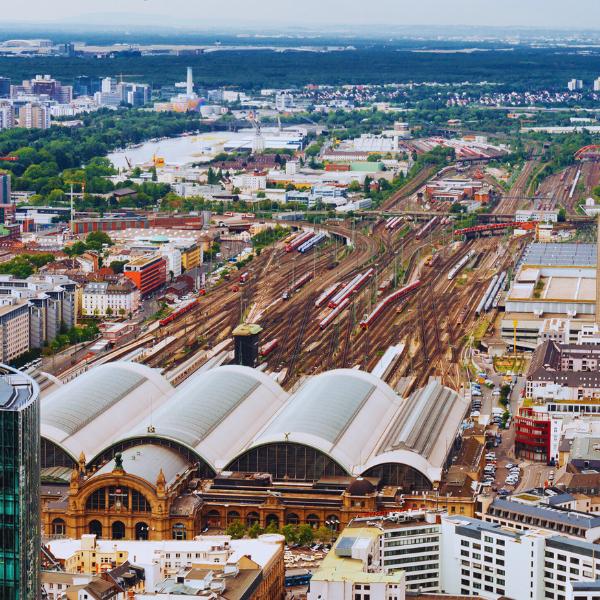 Welcome to one of the busiest train stations in Hesse!
Welcome to one of the busiest train stations in Hesse!Did Someone Say Road Trip?
Starting from one of Hesse's most bustling train stations, the Frankfurt Central Station is where you can hop on your first train. From here to the end of your train journey, it can be anywhere between 2 and 3 hours, depending on the number of stops between stations.
- Start at Frankfurt Central Station - To Mainz - Koblenz Hbf - Cochem
From Cochem Mosel Station, it's around 1.6 km to Cochem Castle. From the train station, there is a shuttle bus service that will take you directly to the castle.
Now, you can avoid walking up that crazy hill!
Keep in mind that these shuttles aren't typically in service during the winter months. But you won't have a problem finding them between May and October.
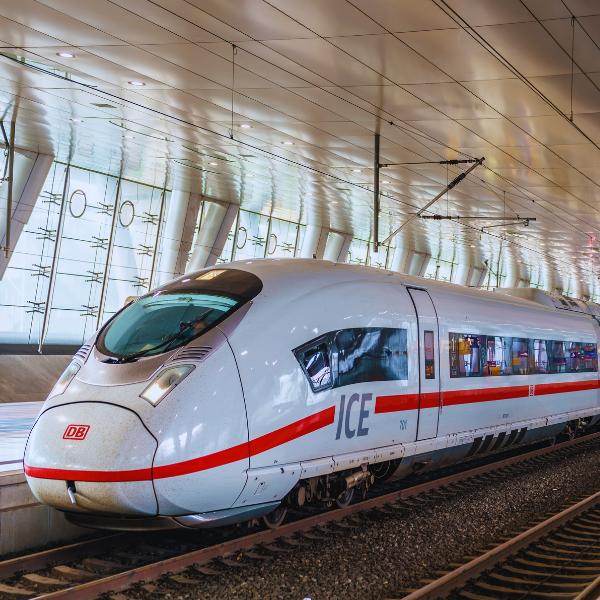 The high-speed trains at Frankfurt Central Station will get you to Cochem Castle in a jif!
The high-speed trains at Frankfurt Central Station will get you to Cochem Castle in a jif!If you think Neuschwanstein Castle went through the wringer to become the beauty seen today, you have yet to hear of Cochem Castle.
This stronghold is the definition of "things will get worse before they get better."
Where It All Began
The castle first dug its roots into the Cochem town hilltop in the year 1000 A.D. and served as the living quarters for the Rhineland-Palatinate counts, including the respected Count Ezzo, also known as Ehrenfried.
According to multiple records, in 1051, the fortress was gifted to one of his daughters.
Cochem Castle stayed in the family of counts for the next century. But this was just the beginning tale of the castle's many ownerships and renovations.
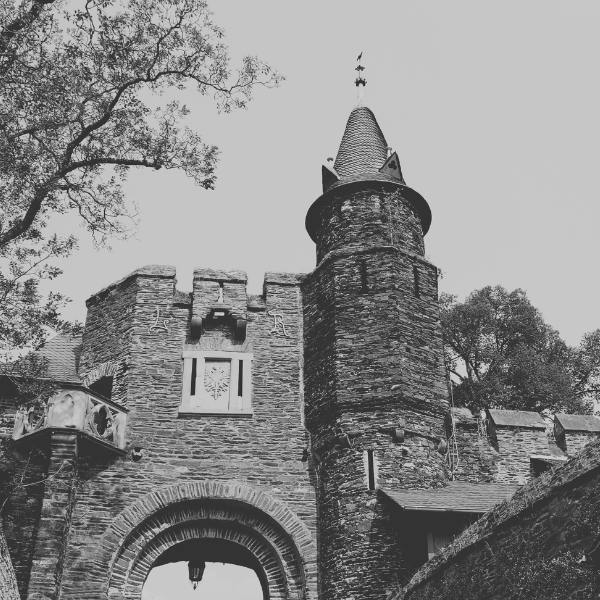 Cochem castles architecture is one for the books.
Cochem castles architecture is one for the books.From A Humble Home to Imperial Fortress
In the late 1100s, King Konrad III occupied the castle with troops and his followers during the second crusade, which he was a partner in leading.
The crusades' objectives were to reclaim former Christian territories through Jerusalem, Europe, and the Mediterranean.
Due to his high power, he took over Cochem castle, turning it into an imperial fiefdom. It was now known as the Imperial Castle of Cochem.
Konrad passed away shortly after taking the castle as his own, and for centuries after, the castle bounced around in ownership by different rulers and archbishops.
What does it mean to be a fiefdom?
What does it mean to be a fiefdom?
To be a fiefdom means he estate controlled by a feudal lord; a fief.
What is Imperialism?
What is Imperialism?
Imperialism is a policy of extending a country's power and influence through diplomacy or military force. Or, historic rule by an emperor.
Castles aren't typically called fortresses just for their looks but for their purpose during battle.
Legend has it that this fortress once held over 40,000 knights before the Nine Years' War, which took place from 1688 to 1697.
During this war, French King Louis XIV's troops burned the castle to a crisp, leaving nothing but a pile of rubble and ruin.
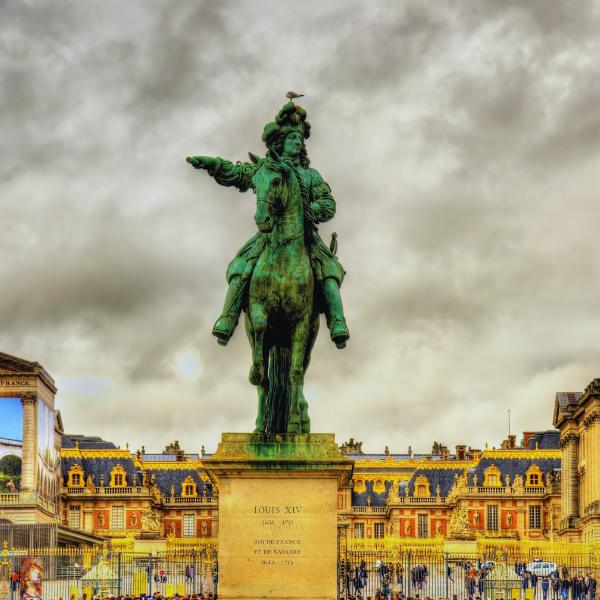 King Louis XIV statue at Versailles, looking dapper and ready to lead on to Cochem!
King Louis XIV statue at Versailles, looking dapper and ready to lead on to Cochem!A Grandiose Restoration of Neo-Gothic Wonder
The castle lay deserted in ruin until 1868 when a well-to-do Louis Ravené- to sound even more snazzy: Louis Fréderic Jacques Ravené from Berlin decided to buy the land and create his own Cochem castle among the wreckage.
With money burning a hole in his pocket as a Councillor of Commerce, Louis had all ambition to make this the Neo-Gothic castle of his dreams for his family's summer home.
The original castle was built in a Romanesque style with Gothic elements and features. So, leaping from this to Neo-Gothic is quite a jump!
Romanesque? Neo-Gothic? I know what you're thinking: "Lydia, speak English, please..." What do these styles mean?
See my page on castles vs palaces to find out the characteristics of what makes these styles so significant.
Mr. Ravené built his castle on ruins during the exact time that Mad King Ludwig built his palace on ruins: Neuschwanstein! Great minds think alike?
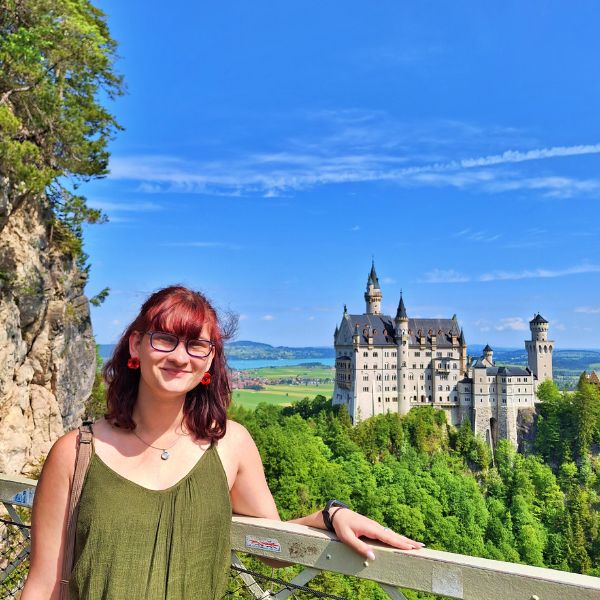 That's me! In front of the famous Neuschwanstein Castle in Bavaria, Germany
That's me! In front of the famous Neuschwanstein Castle in Bavaria, GermanyAlthough he changed most of the architecture from its historic vision, Louis kept a few elements of the old Romanesque and Gothic style, such as the Witches Tower, Hexenturm, and Octagonal Tower.
The new and refined version of the castle, courtesy of Ravené, is the hilltop masterpiece tourists travel near and far to see daily.
The castle architecture is now much similar to the famous Burg Eltz castle complex near Cologne. Both mysterious strongholds in close neo-gothic styles, with a revamped warm and cozy inside!
Castle Tours
Summer Tours: March 15 - November 1, 2025. Open every day 9.30 a.m. – 5.00 p.m.
Winter Tours: November 2 -December 23, 2025. Open Every day 10.00 a.m. – 3.00 p.m.
You'll need to take a guided tour in order to tour the grounds, inside, and courtyards of the castle.
And though the castle is in Germany and many tours are in German, English tours are offered as well.
Meet up with your tour guide and get an in person look at what life was like living in a quiet German town, from the inside of a massive stronghold. See rooms like the dining hall, trophy room, and more!
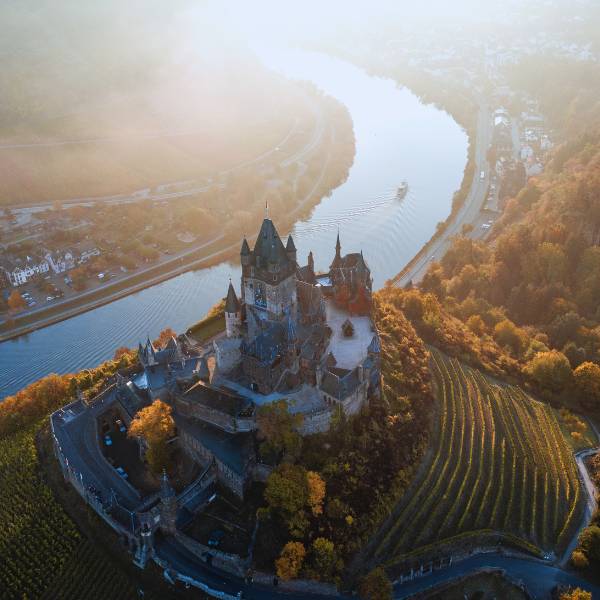 Cochem Castle is towering over the serene Mosel River!
Cochem Castle is towering over the serene Mosel River!Tour List
- Servant tour
- On the trail of Ravené
- “Knight’s Meal”
- Lantern tour (only during Advent)
- “Cochem Advent Magic” (only on the 2nd weekend of Advent)
- “Cochem Castle Christmas” (only on the 3rd weekend of Advent)
Are you traveling with your furry friend? It's your lucky day—dogs are allowed to join you on the tour inside the castle. The only place your pup may not be welcome is if you stay for the knight's meal.
Knight's Meal
Prices 2024:
64€ (69.19 USD) per adult
32€ (34.60 USD) per child (6 to 12 years)
Let's set the scene: You've wandered and pondered through Cochem castle halls, immersing yourself in a whole new world of historical knowledge; you've seen the remarkable architecture.
You've seen the servant's quarters, the trophy and weapons room, the knight's hall, the courtyard, and more.
Then you smell something... you sniff around... you follow your nose, and it leads you to the cellar. You hear music? You go in. You're welcomed by a Burggraf, who hands you a traditional mulled wine.
Welcome to the Knight's meal, Rittergasterey!
Here, you'll learn even more while indulging in a feast fit for a king: authentically German pork knuckles, fresh bread, and so much more.
Immersive Tours Through Cochem
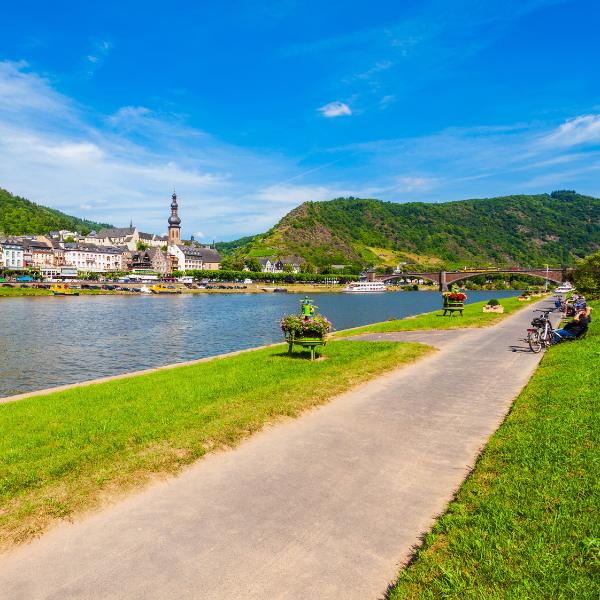 These paved paths go on for miles along the Mosel River. Enjoy the view!
These paved paths go on for miles along the Mosel River. Enjoy the view!- Moselle River Canoe Tour - Embark the waters of the winding Moselle River, paddling your way through the towering hills and vineyards and finishing off with drinks and a tasty traditional meal.
- Bike and Boat Tour with Wine Picnic - Enjoy a relaxing 1-hour boat trip from Beilstein to Cochem, where you'll ride your rental bike supplied for you along the paved paths of valley. Take in the views of the banks of the Moselle River as you have a picnic surrounded by Cochem's beauty, including a wine tasting.
- Panoramic Cruise on the Moselle River- Take in the views from Cochem to Ernst, where you'll pass under Skagerrak Bridge, see the remarkable hilltop castle, Brauselay Mountain, and a stopover in Ernst. This 1-hour ride is enjoyed on a 3-level boat with an onboard bar and snacks. Pick your spot, your favorite wine, and take it all in!
Skagerak Bridge View
Built in 1925, the Skagerak Bridge connects the center of Cochem to the district of Cond.
It offers an excellent photo op spot if you want to capture a special memory!
From this picture-perfect spot, you can see the incredible views of the river running below, the winding ravines, and the hilltop castle—all in one beautiful view.
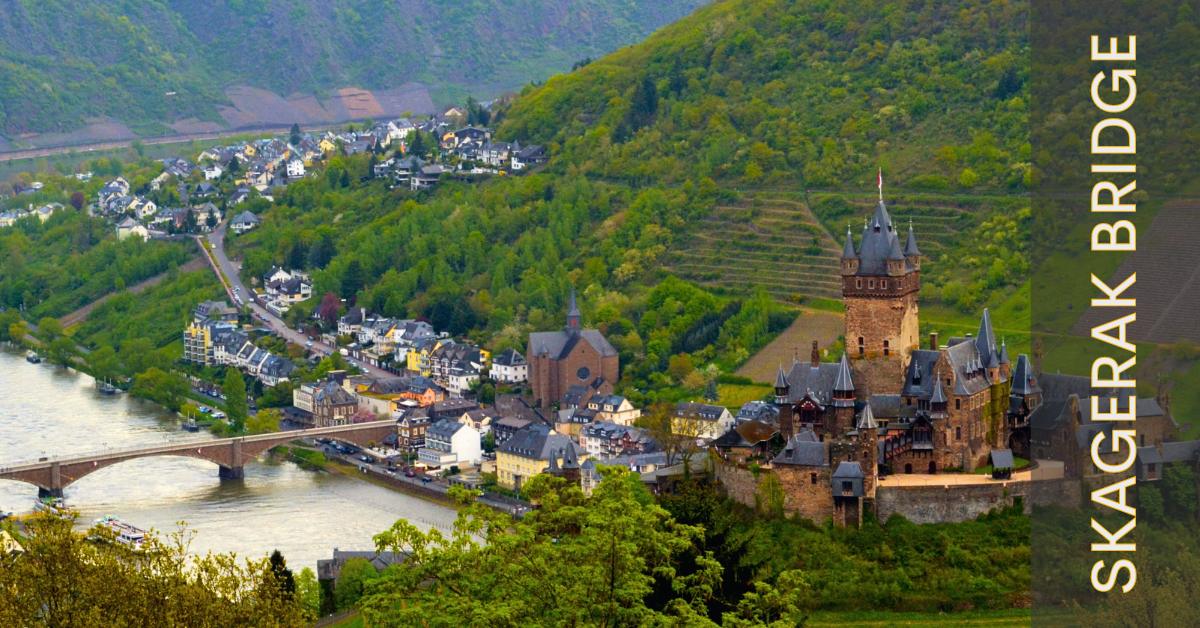 This old bridge attracts just as many tourists as Cochem Castle!
This old bridge attracts just as many tourists as Cochem Castle!What Do You Say?
So? Will you be adding one of Cochem's most beautiful castles on your castle tour?
After a long day spent back in time of the Middle Ages, take in the humble views of Cochem.
Visit the oldest mustard mills, the town hall, market square, and maybe stop by a local cafe and enjoy a German Apfelschorle! (My favorite German drink.)
See the lines of half-timbered houses as you make your way back to the hotel to relax for the night. Don't they look just like a photo on a postcard? Time for a good rest before you carry on your castle bucket list!




